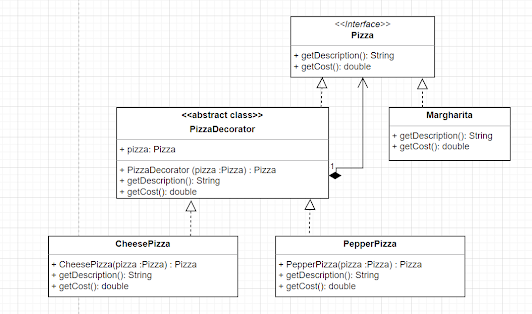Decorator Design Pattern
The Decorator Design Pattern is a structural design pattern that allows behavior to be added to an object dynamically at runtime by wrapping the object in a decorator class. It provides an alternative to subclassing for extending functionality.
Key Components of the Decorator Design Pattern:
Component: It is the common interface or abstract class that defines the operations that can be performed by the objects and decorators.
Concrete Component: It represents the original object to which additional behavior will be added. It implements the Component interface.
Decorator: It is an abstract class that implements the Component interface and has a reference to the Component object. It acts as a wrapper and provides a default implementation for the Component's operations.
Concrete Decorator: It extends the Decorator class and adds additional behavior to the Component object. It overrides the Component's operations and may call the super implementation to preserve the original behavior.
Benefits of using the Decorator Design Pattern:
Dynamic Behavior Extension: The Decorator pattern allows behavior to be added or removed dynamically at runtime. You can wrap an object with multiple decorators, each adding a specific behavior, and combine them as needed.
Open for Extension, Closed for Modification: It follows the Open-Closed Principle, allowing new functionality to be added without modifying existing classes. Decorators can be easily added or removed without affecting the original objects.
Single Responsibility Principle: Decorators add behavior to a specific aspect of an object, keeping each class focused on a single responsibility. This promotes code maintainability and separation of concerns.
Composability: Decorators can be stacked on top of each other, allowing for the combination of behaviors in a flexible manner. Different combinations of decorators can be used to achieve various behavior configurations.
Common Use Cases of the Decorator Design Pattern:
Adding Functionality to I/O Streams: Decorators can be used to add compression, encryption, or buffering capabilities to input/output streams without modifying the original stream classes.
GUI Components: Decorators can be used to add additional features or decorations to graphical user interface components, such as adding borders, shadows, or tooltips to a base component.
Logging or Monitoring: Decorators can be used to wrap objects and add logging or monitoring behavior, such as recording method invocations, measuring performance, or logging error information.
Caching: Decorators can be used to wrap objects and add caching functionality to improve performance by caching expensive operations or results.
Overall, the Decorator Design Pattern provides a flexible and dynamic way to add behavior to objects at runtime. It allows for the incremental addition of features without modifying existing classes, promoting code reusability and maintainability.

Comments
Post a Comment